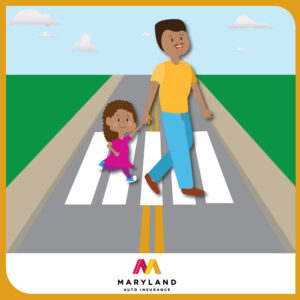October is Pedestrian Safety Month. The Governors Highway Safety Association found that “pedestrian deaths are increasing faster than all other traffic fatalities.” Both pedestrians and drivers must work together to promote safety and ensure that everyone stays out of harm’s way.
According to Zero Deaths Maryland, “Approximately one out of every four people killed in Maryland in a traffic crash was a pedestrian on foot.” Between 2018 and 2022, Maryland averaged 2,793 crashes involving pedestrians, with 2,785 pedestrians injured and 129 pedestrian fatalities, as reported in the Maryland Crash Data Dashboard.
Pedestrian safety is a shared responsibility that demands attention, awareness, and adherence to the rules of the road. Here are some safety tips for drivers and pedestrians.
DRIVERS:
Watch for pedestrians at intersections. When driving, you should always watch for pedestrians, especially at intersections, even where crosswalks don’t exist. Use caution when turning at intersections, and be prepared to stop if there is a pedestrian crossing the street. Always use your turn signal so pedestrians know you plan to turn.
Follow speed limits. Pedestrian and cyclist traffic levels on roads factor into determining speed limits in Maryland. Areas with lower speed limits often have more pedestrians. Cars driven at higher speeds increase the chances a pedestrian is hit and the severity of their injuries. Pay attention to reduced speeds in school zones – especially when the school zone signs are blinking.
Respect crosswalks. Maryland law requires motorists to stop for pedestrians at crosswalks and intersections. When approaching crosswalks, you should slow down and look for pedestrians. Never pass vehicles that are stopped at a crosswalk, and always obey crossing guards.
Ditch distractions. You should never drive distracted. Staying aware of your surroundings is always important, especially when you are driving around pedestrians. According to the non-profit In Control, “looking at one text has been found to tie up your brain for the next 27 seconds.” Other distractions may include eating, changing the radio station, and interacting with passengers.
Stop for school buses. When a school bus is slowing down or stopping, you should pay attention to the bus and the surrounding area. Children getting on or off of the bus often cross the street nearby. It is illegal to pass school buses when the stop arm is extended and red lights are flashing.
RELATED: 4 Ways to Drive Safely Around School Buses
Be cautious at night and in bad weather. Visibility can be reduced at night and during inclement weather. Drive with extreme caution during these times to make sure see any pedestrians.
Watch for pedestrians when backing up. When backing up, check your blind spots, go slowly, and be prepared to stop suddenly. Be sure to keep watching behind your car and in your mirrors as you back up to prevent hitting pedestrians.
PEDESTRIANS:
Stay visible. If you’re walking at night, make sure you’re wearing light or bright-colored clothing. Reflective fabrics can also increase your visibility to vehicles driving down the street. According to the U.S. Department of Transportation Federal Highway Administration, “Studies show that pedestrians walking in dark colored clothing at night are first seen approximately 55 feet away – giving the driver traveling at 60 mph less than one second reaction time.”
Use crosswalks. Crosswalks are put in place to protect pedestrians crossing at intersections. The crosswalk areas may also have streetlights nearby to make you more visible. If a signal that tells you when to cross is present, obey it to ensure it is safe to enter the roadway.
Look before crossing. If you’re crossing a road or intersection that does not have crosswalks, look left, right, and left again to ensure no vehicles are approaching before you cross the street.
Put your phone and headphones away. It may be tempting to look at your phone or listen to music while walking, but this distraction can prevent you from being aware of what is happening around you.
Walk Defensively. Not all drivers will see you, so always assume they don’t. Make eye contact with drivers if possible, and be ready to step back if a vehicle appears to be approaching too quickly.
Stay on the sidewalk. Always use the sidewalk when one is available. In areas without a sidewalk, always walk on the side facing oncoming traffic, so you can react if an approaching vehicle puts you in danger.
Watch children and pets. Teach children the basics of pedestrian safety, and always hold their hand when crossing the street. Keep pets on a leash to prevent them from darting into traffic.
For more information, visit:
- National Safety Council – Take Steps to Avoid Injury or Death While Walking
- National Safety Council – Slow Down: Back to School Means Sharing the Road
- National Highway Traffic Safety Association – Pedestrian Safety
- National Highway Traffic Safety Association – School Bus Safety
- Safe Kids Worldwide – Pedestrian Safety Tips
- Center for Disease Control and Prevention – Pedestrian Safety
- United States Department of Transportation – Pedestrian Safety
- Maryland Department of Transportation State Highway Administration – Pedestrian Safety




